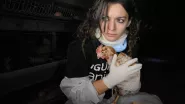It ́s an ode.
An ode to limbic people.
And the people exploring their realities.
Even the most apologetic civilizations have opened their vulnerability to defeat. Willingly or involuntarily, they have ceased power to minorities, outsiders, the so-called social pathogens. Blindly ignoring that isolated universes are as fake and unnatural as sedentarism itself. That their apparent lost game, was in fact, an injection of opportunity.
Empires searching to stop mobility, with boundaries like nets and people like pollen. With frontiers as tangible as air, but intangible doesn't mean nonexistent. Between the mass-lacking-entities, we can also find heaven and hell. A heaven with polyester promises of abundant metal coins in worn-out pockets and hell with the same pockets, but empty. The two spaces like great dualities, stretching in and out of coherence, can't save themselves from the gradient spectrum. The inevitable medium where end and beginning collide: limbo.
Limbo. Dwelling of the foreigners, mansion of the homeless. The once called habitats, now exchanging their future for a shovel with an engraved label: migrant. Those brave enough to enroll themselves in the unwinding path of a promised land, sacrificing their identity, their roots, and from time to time, their lives.
These limbic people go marching through the hero's journey, being sold liberty as a flag for the misunderstood, ignoring the fact that deciding to embark on the odyssey marks them forever with the well known original sin. A sin that condemns them to limbo, and limbo only. Too low for paradise, too high for underworld. With skin too dark to ever belong in the new world, and their hopes too elevated to remain on their homeland. Limbic people are the ones that got away, but limbo is far from relating to just them. In words of medieval theologists, there is a “limbo of the fathers and patriarchs and limbo of the infants”. The space for those not guilty but not quite innocent: the ones, in a way, involuntarily dragged into a state of lukewarmness for their predecessors' actions.

Here, on the edge of ghost towns left by limbic people, we find not the ones that got away but the ones left in the nest.
(
), creative director, photographer, and founder of
The Other Half
, was particularly interested in “those who stayed, what they think and dream ... the ones that abandon the straw hats and rubber boots for the t-shirts with American wrestling characters and gummed hairstyles”. Aragón, as a living witness of the changing horizons, became curious about the waiting half. How people dealt with living in limbo with the ghosts of the north seekers. Her project
, set in Guatemala, becomes a radiography of the collateral effects of migration on the side of the “underworld”. How the mutilated families mutate into U.S souvenir mailboxes, being the destination addresses for all sorts of elements from plasma TVs to remittances.
Those gifts serve not just as reminders of the faraway members, but as a dispersion channel of fluctuating identities. They became totems of distant cultural paradigms that gnaw at the surface of the originality of their nations. Humans need a sense of belonging, even if it means belonging to a distant utopia. They don't entirely cope with their roots, because their heads and gazes are above an intangible sky, that took away their sons and daughters, mothers and fathers.
This fluid cultural fusion happens both ways, in a centripetal and centrifugal way. It also lights up the meaningful role of mobility on the creation of identity and survival, as Aragón herself would state: “We are all migrants, in some aspects of our lives we may feel alienated or odd in different spaces, and we carry the memories and objects that give us comfort to survive.”





